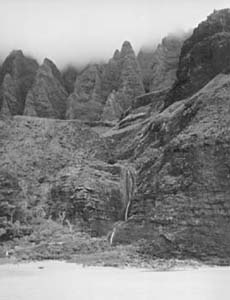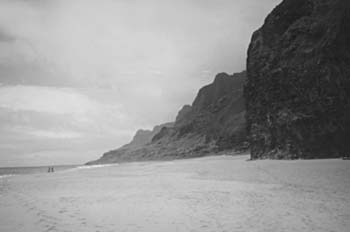Cliff Hanger
Two nice suburban girls rough it on Kaua'i's Na Pali coast
By Traci Hukill
SIPPING HER MAI TAI, Carol said, "It's only 11 miles. There's a place where we can camp halfway if we don't want to hike it all at once. That'll still give us two nights in Kalalau." She paused, noting my skepticism. "You'll love it," she promised sagely. "Kalalau's magical."
I'd just quit a very glamorous job as a cocktail waitress in which I wore a polyester tennis skirt and flowers in my hair. After a season of running daiquiris to perspiring Midwesterners on vacation, my own vacation--even the backpacking variety--sounded like a gift from the gods. So two weeks later, we dragged our bulging backpacks aboard a Hawaiian Air 747 bound for Kaua'i.
We touched down in Lihu'e early in the day and hitched our way around the island. Shortly after noon, we bade farewell to Bill the acidhead in the Chevy van, hoisted our packs on our backs and started up the Kalalau trail from Ha'ena State Park on the leeward side of the Na Pali coast.
The plunging mountains and turbulent sapphire waters that make up this wild and ancient stretch of coast (whose imaginative name means "The Cliffs") have played starring roles in South Pacific and Jurassic Park. They were hired for their looks. Travel-book hyperbole aside, the Na Pali truly is one of the most beautiful, and one of the last untamed and undeveloped, places in the Hawaiian Islands. The only way in is by trail or by boat, and half the year an irascible Pacific heaves monstrous winter surf at the coast, making landings impossible. So undeveloped it remains.
That's not to say it's unpopulated, exactly. On the first two miles of trail--a mildly strenuous upward jaunt through lush, perfumed terrain--we passed a stream of red-faced men and women in ball caps and gold lamé visors. The Midwesterners were here, too, and they'd exerted themselves getting to Hanakapiai.
The only accessible beach until Kalalau, Hanakapiai is the mouth of a valley two miles deep. A web of trails, unbelievably slick in rainy weather, follows the river through bamboo stands and guava forest to a gratifyingly massive waterfall. But that was for a different trip. We were on a mission, and we stopped in Hanakapiai only to eat and put moleskin on our nascent blisters.
Open-Toe World
A WORD ABOUT footwear: Whatever unfortunate message they convey about the wearer's taste, sports sandals are the secret to happiness on the Na Pali trail. We did not know this. I was in hiking boots, which meant my socks were soaked from brushing thickets of wet ferns that threatened to consume the trail. And although we lucked out and went in June (July and August are also dry), we could have had to navigate innumerable river crossings. Carol, for her part and for reasons I will never understand, wore reefwalkers and so spent our days in Kalalau nursing evil quarter-sized blisters.
From Hanakapiai on, the going got tougher and the meetings with other hikers rarer. We climbed up to 1,000 feet through the dry grassy hillsides that characterized the outermost mountains and then back through humid, verdant valleys, lacing our way along the coastline just above impassable crashes of rocks and thick jungle.
The view was stunning. Always in sight, the sea's aquamarine shallows shivered under the white froth of waves below, then gave way to turquoise and, finally, indigo farther out. Flocks of small, hardy goats grazed on steep slopes and perilous outcroppings, impervious to our approach. Loneliness there had a magnificent quality.
And our packs began to assume magnificent weight. Somewhere between miles five and six--our pace was a blistering mile an hour--it became obvious that the camp-halfway plan was the way to go. In Hana Koa, we pitched our tent and bathed in a stream, to the delight of the peeping Boy Scouts also camped there, and realized at dinnertime that Carol had forgotten to pack matches. We ate a dry dinner of trail mix and crawled inside our tent to escape the mosquitoes.
Blessedly, Hana Koa is now closed until further notice. The good news is that when it reopens there will be toilets. The bad news is the mosquitoes will still be there. Dark and so damp is the spongy ground, the place belongs to the bugs. We set a record striking camp the next morning just to get out of there.
Kalalau was still a half-day's hike away, up and down switchbacks, through more valleys. Finally the terrain started to change, open up, dry out. To the left hovered an assortment of Disneyesque peaks covered in velvety canopy, to the right the sparkling Pacific, and ahead a swath of chaparral guarded a perfect, pristine white sand beach a hundred yards wide. Kalalau. We'd arrived, and we couldn't see a soul.
Travel-book hyperbole aside, the Na Pali truly is one of the most beautiful, and one of the last untamed and undeveloped, places in the Hawaiian Islands.
Naked Yoga
EXCEPT FOR OUR NUDE one-woman welcoming committee, who interrupted her hillside yoga session to give us a spacy Earth Mother sort of blessing. "It's the most beautiful place on earth," she breathed, looking like she was about to pass out. "The mangos in the valley are delicious." Later we learned she was an attorney from D.C. who brought her boyfriends here, one per year. That last bit of knowledge, recently come to light, was tormenting her current companion, a slight, pale guy who'd evidently hoped he was a special case. They kept showing up at our camp in nothing but hiking boots, which was kind of cute.
Kalalau is indeed a clothing-optional destination. It's also a family destination. As we stumbled through the sand to a site near a cave, we passed a couple of families camped together. The park rangers only allow 60 campers at once in Kalalau, so large groups have to plan in advance if they want to be legal. On the other hand, we didn't see anybody checking permits.
It took a few hours for Kalalau's magic to take effect. When it did, it went like this: Sleep. Wake up. Swim. Walk to the waterfall for water. Sleep. Wake up ... and so on. For two days, we drifted in weightless, timeless atmosphere, sleeping at the base of enormous cliffs that stayed sun-warmed into the night, watching stars wheeling across a panoramic sky, swimming in warm clear waters. In the evenings, the air itself seemed to glow rosily, and all day and all night the waves' low thunder droned on.
Best of all, we didn't have to see anyone. There was enough solitude for everybody.
One day I went up the valley to get some of those mangos, but I didn't get far. The first tree was in close range, and so full of sweet, juicy drops of sunshiny fruit that I just didn't feel any more searching was required of me. I think I spoke to someone when I borrowed matches. Chatted with the nudists some. And that was about it.
Silence.
Gold Rush
THE RHYTHMS WERE so satisfying that in two days I felt OK about leaving that slice of Paradise. I had an appointment in Lihu'e scheduled for the day we were to hike out, so I opted to take the 30-minute Zodiac ride back to Ha'ena. I sat on the beach that morning waiting for the boat and watched the sun rising, bursting out of the water like hot new gold.
A half-hour later, the boat came up with a fresh load of campers to deposit. I paid my 90 bucks and swam out to board while a man with an Aussie hat loaded our packs onto the baggage dinghy. The ride back was cold and spectacular, and I waved to Carol as we passed her from several hundred yards offshore. Without her pack, she was making good time, and I could see her waving back.
We zipped along the coast and took a spin through a gargantuan sea cave, its roof arched far above us like a hollow rib cage. And then the ride was over, they were helping us out of the boat, and I caught a ride into Hanalei with a Kramer-looking guy who turned out to be from my hometown in New Mexico. We talked some, but mostly we just drove in quiet.
I re-entered civilization slowly, mile by mile and sound by sound. Kalalau's magic clung to me for a few days, and those nights I slept very well, the sound of waves rushing through my head.
Copyright © Metro Publishing Inc. Maintained by Boulevards New Media.
![]()

Traci Hukill
Traci Hukill
For camping reservations in Kalalau, call 808/274-3444. It's free.
From the May 7-13, 1998 issue of Metro Santa Cruz.
![[MetroActive Travel]](/gifs/travel468.gif)